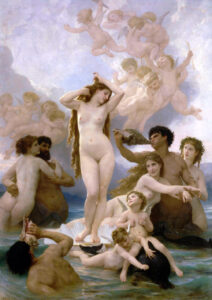Love immortalised: 5 of the most beautiful works of art dedicated to love
Love, in all its many facets, has always been a source of inspiration for artists throughout history. In the world of painting, this universal emotion has been captured with remarkable intensity and beauty. From the masterpieces of the Renaissance to the iconic canvases of the modern era, love has been depicted in a variety of ways, each reflecting the cultural norms, aesthetic ideals and sensibilities of the artists.
Focusing on the role of colour in the artistic expression of love, this article explores some of the most beautiful paintings dedicated to this theme, highlighting how shades and tones have been used to convey emotions and create unique atmospheres.
“The Kiss” by Gustav Klimt

Gustav Klimt’s “The Kiss”, created between 1907 and 1908, is not only a hymn to romantic and sensual love, but also a masterpiece that marks the apogee of Klimt’s career and his unique style, characteristic of the Viennese Secession.
This movement, to which Klimt made a major contribution, sought to break with traditional artistic conventions and promote freer, more expressive art. The work is set against the backdrop of a period of social and cultural change in Europe, particularly in Vienna at the beginning of the 20th century.
It was a time of great transformation, when the old world was giving way to new ideas in art, psychology, politics and philosophy. Painting reflected this transition, symbolising both an escape from conformity and an exploration of sensuality, themes often neglected in the academic art of the time. Klimt’s choice of gold leaf is also significant. Inspired by his trip to Italy, where he was impressed by Byzantine mosaics, Klimt incorporated this element to add a spiritual and ethereal dimension to the work. This technique helped establish his golden period, during which he created some of his most famous works.
In sum, ‘The Kiss’ is not only a depiction of passionate love, but also an expression of the revolutionary artistic spirit of its time, blending influences from history, art and culture.
“The Lock” by Jean-Honoré Fragonard

Jean-Honoré Fragonard’s “The Lock”, painted in the 18th century, illustrates a more daring and passionate side of love, in contrast to the more restrained and idealised representations of the period. This work is part of the Rococo movement, known for its ornate, exuberant and often sensual style. Fragonard, one of the masters of this movement, was renowned for his galant scenes and playful depictions of the aristocracy. The period in which “Le Verrou” was created was marked by a French society in the throes of political and social change, just before the French Revolution. The art of this period often reflected the underlying tensions and indulgences of the aristocratic class.
In this context, ‘Le Verrou’ can be seen as an exploration of love and desire at a time when these themes were often veiled in metaphor and subtle implications. The choice of colours, particularly the fiery reds and golden yellows, and the use of dramatic lighting, not only capture the intensity and passion of the scene, but also reflect the Rococo tendency to privilege emotion and individual expression.
Fragonard’s work, with its personal touch and unique interpretation of traditional subjects, offers a glimpse into the complexities of romantic relationships of his time, while demonstrating his talent for capturing fleeting moments with great vividness.
“Spring” by Sandro Botticelli

Sandro Botticelli’s “Spring”, painted at the end of the 15th century, is an emblematic work of the Italian Renaissance. This captivating painting explores eternal beauty and fertility through a composition rich in mythological symbols. Set in an idyllic landscape, the scene features a group of allegorical figures, notably Venus, the goddess of love, surrounded by the Graces and Zephyr, the spring wind.
Botticelli’s work is set against the backdrop of a period when the rediscovery of ancient texts and the fascination with classical mythology inspired Renaissance artists. “Spring” embodies the celebration of nature, fertility and rebirth, themes dear to this period of cultural transition.
The soft colour palette, elegant forms and anatomical precision characteristic of Botticelli’s style contribute to the timeless grace of the work. The meticulous details, such as the flowers that line the floor and the floral ornaments in the hair of the female figures, add an exquisite delicacy to the composition.
Botticelli’s “Spring” is not just an artistic representation, but also functions as an allegory of the cyclical nature of life, birth and renewal. This work, imbued with symbolism, offers a window onto the spirit of the Renaissance, when art became a means of exploring the depths of philosophical concepts and my
“Roméo et Juliette” by Frank Dicksee

Frank Dicksee’s “Romeo and Juliet”, painted at the end of the 19th century, embodies the romantic Shakespearean tragedy in a visually captivating way. This striking painting offers an artistic interpretation of the famous love story, highlighting the heart-rending passion between the two young lovers.
Dicksee, from the Victorian period, has brilliantly conveyed the emotional intensity of the romantic drama. The scene, bathed in subdued light, highlights the tenderness and despair in Romeo and Juliet’s expressive faces. The skilful use of colour, with rich tones and subtle nuances, helps to create a poignant emotional atmosphere.
Dicksee’s artistic composition underlines the impending tragedy, with the lovers locked in a passionate embrace in the foreground, contrasting with the dark elements in the background. The meticulous detail of the costumes and props reflects the Shakespearean era, while adding a visual dimension to the dramatic expression of the characters.
Dicksee’s work transcends the simple act of depicting a scene from “Romeo and Juliet”. It captures the very essence of romantic tragedy by exploring the emotional depths of young love confronted by insurmountable obstacles. Dicksee’s artistic interpretation helps to perpetuate the timeless power of this universal story of love and loss.
“The Birth of Venus” by William-Adolphe Bouguereau

William-Adolphe Bouguereau’s “The Birth of Venus”, painted at the end of the 19th century, is a masterpiece that forms part of the artistic movement of Academism. This mythological depiction of the goddess Venus emerging from the waters is an eloquent example of Bouguereau’s technical mastery and his ability to capture classical grace.
The work is set in a mythical landscape, where Venus, the goddess of love and beauty, emerges from the waves, carried by sea creatures. Bouguereau paints anatomical details with remarkable precision, creating a female figure of idealised beauty. The soft colours and delicate nuances contribute to a harmonious aesthetic, reinforcing the sensation of softness and perfection.
Bouguereau’s composition, with Venus at the centre of the work, surrounded by naiads and tritons, recalls classical representations of Greek mythology. The artist skilfully combines the academic tradition with a personal interpretation, offering a refined and romantic vision of the birth of the goddess.
“The Birth of Venus” bears witness to Bouguereau’s talent for transcending his era by capturing timeless classical aesthetics while incorporating an artistic sensibility specific to the nineteenth century. The work is a tribute to idealised beauty, reinforcing the idea that art can be a link between past and present, while celebrating the eternal splendour of mythological themes.
Through these masterpieces, we can see that colours play an essential role in the representation of love in painting. They don’t just serve to embellish; they are a powerful tool for conveying emotions, creating atmospheres and expressing ideas. From the dazzling passion of Klimt’s “The Kiss”, the mythological splendour of Botticelli’s “Spring” to the romantic tragedy of Dicksee’s “Romeo and Juliet”, and finally the divine beauty of Bouguereau’s “The Birth of Venus”, each work depicts a unique facet of love.
These paintings, in their diversity and beauty, continue to inspire and move, proving that love, in all its complexity, remains a universal and timeless theme in art.




